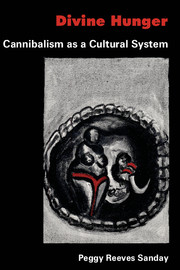Book contents
- Frontmatter
- Contents
- Preface
- Acknowledgments
- Introduction
- The symbols that give rise to a cannibalistic consciousness
- The mythical chartering and transformation of cannibal practice
- 6 The faces of the soul's desires: Iroquoian torture and cannibalism in the seventeenth century
- 7 Raw women and cooked men: Fijian cannibalism in the nineteenth century
- 8 Precious eagle-cactus fruit: Aztec human sacrifice
- 9 The transformation and end of cannibal practice
- 10 Conclusion: Other symbols and ritual modalities
- Notes
- References
- Index
6 - The faces of the soul's desires: Iroquoian torture and cannibalism in the seventeenth century
Published online by Cambridge University Press: 05 June 2012
- Frontmatter
- Contents
- Preface
- Acknowledgments
- Introduction
- The symbols that give rise to a cannibalistic consciousness
- The mythical chartering and transformation of cannibal practice
- 6 The faces of the soul's desires: Iroquoian torture and cannibalism in the seventeenth century
- 7 Raw women and cooked men: Fijian cannibalism in the nineteenth century
- 8 Precious eagle-cactus fruit: Aztec human sacrifice
- 9 The transformation and end of cannibal practice
- 10 Conclusion: Other symbols and ritual modalities
- Notes
- References
- Index
Summary
[T]his “contempt” for the body [as shown in eighteenth century public tortures and executions in Europe] is certainly related to a general attitude to death; and, in such an attitude, one can detect … a demographical, in a sense biological, situation: the ravages of disease and hunger, the periodic massacres of the epidemics, the formidable child mortality rate, the precariousness of bioeconomic balances – all this made death familiar and gave rise to rituals intended to integrate it, to make it acceptable and to give a meaning to its permanent aggression.
Many early commentators on the Indians of eastern North America described the emotional satisfaction evident in the prolonged tortures inflicted upon war captives, which in many cases ended with the death of the victim and consumption of parts of the body. The motive for cannibalism was to appease the appetite of the war god who demanded that captives be taken and eaten. The motive for torture was to avenge the death of a family member lost in war. It was customary to adopt war captives. Some were allowed to live and assume the rights and duties of the family members lost in war; others were tortured to death and eaten. In a fundamental sense, it did not matter whether the victim was allowed to live or was tortured to death, because in either case the victim was physically incorporated into the community.
- Type
- Chapter
- Information
- Divine HungerCannibalism as a Cultural System, pp. 125 - 150Publisher: Cambridge University PressPrint publication year: 1986



